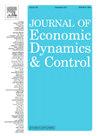动态寡头垄断实验中的噪声学习建模
IF 1.9
3区 经济学
Q2 ECONOMICS
引用次数: 0
摘要
在生产前估计需求对许多行业构成重大挑战,包括疫苗制造、报纸和易腐食品。工业专业人员和实验对象在实验室设置往往难以确定最佳生产。本文利用Nagel and Vriend, 1999a, Nagel and Vriend, 1999b的数据,阐明了解释个体无法做出最佳行为的认知过程。在他们的实验中,参与者作为公司,在事先不知道自己和竞争对手的广告努力所产生的需求的情况下设定生产水平。我们首先重新审视了他们的两步学习模型,该模型涉及生产水平的定向学习和广告的爬坡算法,利用外生调整大小分布。受宏观经济学习文献的启发,我们改进了这个模型,代理使用恒定增益学习来进行生产决策,并使用爬山来进行具有内生调整的广告决策。我们证明,我们的模型比Nagel和Vriend (1999a)的原始模型提供了更好的数据拟合,并产生了更好的样本外预测,无论是对一个周期的预测还是模拟路径。本文章由计算机程序翻译,如有差异,请以英文原文为准。
Modeling noisy learning in a dynamic oligopoly experiment
Estimating demand before production poses a significant challenge for many industries, including vaccine manufacturing, newspapers, and perishable foods. Both industry professionals and experimental subjects in laboratory settings often struggle to determine optimal production. This paper sheds light on the cognitive processes that explain individuals' inability to act optimally, using data from Nagel and Vriend, 1999a, Nagel and Vriend, 1999b. In their experiment, participants, acting as firms, set production levels without prior knowledge of the demand generated by own and competitors' advertising efforts. We first reexamine their two-step learning model, which involves directional learning for production levels and a hill-climbing algorithm for advertising, utilizing exogenous adjustment size distributions. We improve upon this model, inspired by the macroeconomic learning literature, with agents using constant gain learning for production decisions and hill climbing for advertising decisions with endogenous adjustments. We demonstrate that our model provides a better fit to the data than the original model by Nagel and Vriend (1999a) and yields superior out-of-sample forecasts, both for one-period-ahead predictions and simulated paths.
求助全文
通过发布文献求助,成功后即可免费获取论文全文。
去求助
来源期刊

Journal of Economic Dynamics & Control
ECONOMICS-
CiteScore
3.10
自引率
10.50%
发文量
199
期刊介绍:
The journal provides an outlet for publication of research concerning all theoretical and empirical aspects of economic dynamics and control as well as the development and use of computational methods in economics and finance. Contributions regarding computational methods may include, but are not restricted to, artificial intelligence, databases, decision support systems, genetic algorithms, modelling languages, neural networks, numerical algorithms for optimization, control and equilibria, parallel computing and qualitative reasoning.
 求助内容:
求助内容: 应助结果提醒方式:
应助结果提醒方式:


